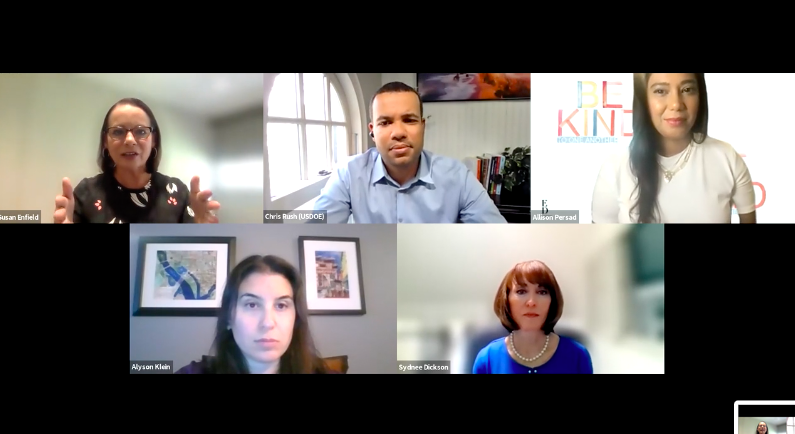The beginning of the school year is approaching, and with it, a major push to return to normal this fall. At the 2021 National Principals Conference, “The State of American Education” session brought together leading local, state, and federal policymakers and influencers to discuss emerging issues in education policy. The session also featured strategies and suggestions for how school leaders can influence the decisions being made that impact their schools. This year’s panelists included Chris Rush, Director of Educational Technology at the U.S. Department of Education Office of the Secretary; Dr. Sydnee Dickson, Utah State Superintendent of Public Instruction; Dr. Susan Enfield, the superintendent of Highline Public Schools in Washington state; and Allison Persad, principal of The Young Women’s Leadership School of Astoria in Astoria, NY. The session was moderated by Alyson Klein, assistant editor at Education Week.

While all panelists agreed that each student deserves the opportunity to return to school in-person, they also acknowledged the lessons that school leaders have learned about distance learning and student success. Dickson stated that “normal didn’t work for every child in the past.” We have seen that learning is “more than just being present in a seat.” Schools must reevaluate what learning means for individual students.
The narrative that distance learning has been detrimental to students was challenged as well. Some thrived in distance learning environments, and the commitment to meet the needs of all students is now greater than ever. Rush stated that we must continue with personalized learning and “shift from a world that thinks one size fits all.” It is important to encourage the effective use of technology to help provide this personalized learning environment for students. The options do not have to be one or the other—but can encompass both.
The mental health of students is a priority for these school leaders, especially coming out of the pandemic. Some innovative ways that the panelists have addressed mental health needs in their schools have resulted from recognizing who the education system is—and is not—working for. Dickson started a 1:1 program in her district where each student was paired with an adult so that relationships would help to sustain them during the pandemic. “We don’t know how people will show up in the fall,” said Dickson. We must “be open to learning the needs of students.”
Persad, who was recognized by NASSP as a 2019 Digital Principal of the Year, added that we must be willing to financially invest in school counselors, even if it means, for now, having floating counselors from other schools in the district. Persad is also striving to create restorative spaces in her school, recognizing the connection between the protests in the wake of George Floyd’s murder and mental health.
The pandemic has also caused school leaders to rethink how student learning is assessed, especially as they address lost instructional time. Enfield stated that while there is a place for standardized testing, “we have to be clear on what we’re testing and what those results are for.” Rush added that he hopes we can adapt standardized testing so “we revise it and can create a map to have an actionable plan without lowering standards for students.” The panelists offered recommendations to school leaders who want to advocate for policies that would allow them to be more innovative in their schools. Persad recommended that school leaders find a buddy, like other principals in their district, and create a strong tribe of strong leaders. She added that “when you come together with other like-minded folks, that’s when you can advocate from a place of making change.”
Help prioritize school needs this fall by getting involved with NASSP’s Policy & Advocacy Center.

1 Comment
Restorative spaces is a great idea that we are currently exploring as we try to create a small one in our wing of the high school!!! The phrase ‘Maslow before Bloom’ has become quite popular in conversations related to schools reopening, and rightly so. I agree that we need to be creative in our approach as we deal with K-12 reopening, while the pandemic takes a new direction with the Delta variant. As an administrator in an urban school district, I constantly think about how to address this additional layer to the already existing equity gap. Where are the extra resources that we need to address SEL and how do we optimize existing resources to ensure that we serve the needs of all students? That’s a conversation that is urgent and needs to happen more consistently and purposefully, and not just as a byline in the larger discussion.